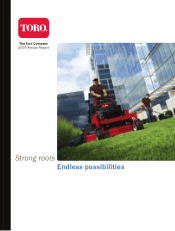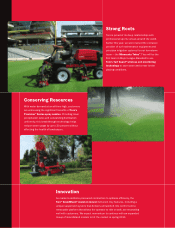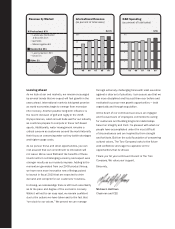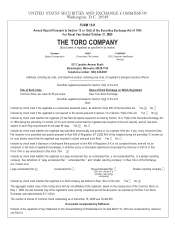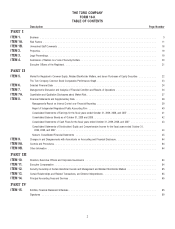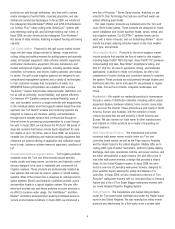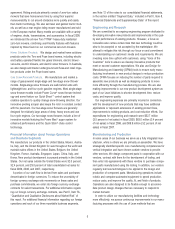Toro 2009 Annual Report Download - page 3
Download and view the complete annual report
Please find page 3 of the 2009 Toro annual report below. You can navigate through the pages in the report by either clicking on the pages listed below, or by using the keyword search tool below to find specific information within the annual report.
As fi scal 2008 drew to a close, we expected that 2009
would be diffi cult but could not predict the severity of
the global economic decline. Moving through the year
our residential business proved to be somewhat more
resilient than our professional businesses, thanks in
large part to new products, expanded placement at
dealers and key retailers, and favorable weather
patterns. Contrasting what we saw in residential, our
professional end markets were hardest hit by the
recession. For example, in our core golf business,
new course development around the world slowed
signifi cantly while existing courses experienced a
decline in revenues, causing them to postpone orders
for maintenance equipment and delay renovation
projects. Among landscape contractors, the economic
uncertainty forced many to extend the life of their
existing fl eets rather than purchase new equipment. Not
to mention, the decline in residential and commercial
construction had a major impact on sales of both
equipment and irrigation products into these markets.
Across all markets and geographies, these persistent
headwinds signifi cantly impacted our revenues and
profi ts. Net sales for fi scal 2009 declined by 18.9 percent
to $1.5 billion. Meanwhile, net earnings for the year
were $62.8 million, or $1.73 per share — compared to
$3.10 per share in fi scal 2008.
Entering these very turbulent times, we focused on a
clear set of priorities and took decisive actions to
maintain our competitiveness so that as our markets
recover we can take advantage of our strong position.
These priorities were:
• Ensuring strong liquidity,
• Focusing on our customers and growing market
share, and
• Managing through the short-term challenges
without materially impacting the long-term health
of the organization.
Strong Financial Discipline
Given the enormity of the credit crisis, ensuring strong
liquidity was paramount — and we did just that. Our
fi nancial discipline paid off as we generated a record
$251.5 million in cash from operating activities. This
was the result of the Red Iron Acceptance joint venture
strategy, a continued focus on asset management and
contributions from earnings. On another positive note,
seasonal short-term borrowing during our peak period
was more than $100 million lower compared to the same
time last year, and we maintained solid relationships
with our credit-line banks. All told, this enabled us to
retain an even more liquid position than in previous
years and fi nish with a very strong balance sheet.
To our valued shareholders,
Looking back over our long and rich history there have
been many challenges along the journey that tested the
strength of our people and our company. Through these
times of adversity we have stood strong and persevered
by driving change in the right direction, remaining fl exible,
keeping a pulse on the needs of customers, and out-
innovating the competition. For these reasons, The Toro
Company has sustained its leadership position in the turf
industry. It’s a reputation built over many years and one
we work hard to protect and grow.
Michael J. Hoffman
Chairman and CEO

